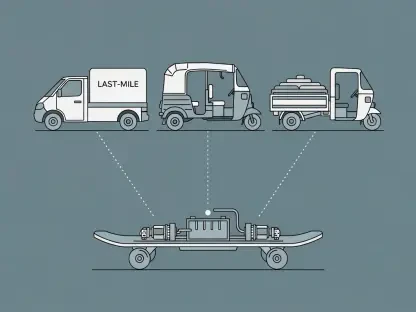In a landscape where global automakers are constantly recalibrating their strategies to adapt to economic and political tides, Stellantis has made a seismic announcement that’s turning heads across the industry, committing a staggering $10 billion investment toward U.S. manufacturing. Under the stewardship of new CEO Antonio Filosa, this automotive giant is embarking on a transformative journey that marks a significant departure from past approaches favoring low-cost production hubs and a heavy European focus, pivoting instead to bolster North American operations. It’s a decision that not only reshapes the company’s footprint but also speaks to broader shifts in the automotive world, where trade policies and regional demands are increasingly dictating corporate strategies.
This substantial financial commitment is more than just a monetary figure; it’s a calculated effort to revitalize key facilities, create thousands of jobs, and introduce new vehicle models tailored for American consumers. With targeted investments in states like Illinois and Michigan, Stellantis is signaling a renewed dedication to the U.S. market. But the question looms large: what drives this focus on American soil at this particular juncture? The answer lies in a complex interplay of political pressures, tariff uncertainties, and the urgent need to rejuvenate iconic brands that have lost ground in recent years. This strategic pivot carries implications that ripple across global markets, labor relations, and competitive dynamics, setting the stage for a deeper exploration of Stellantis’s bold gamble.
Strategic Shift Under New Leadership
A Bold New Direction
Stellantis’s announcement of a $10 billion investment in U.S. manufacturing represents a profound shift in the company’s global strategy, one that starkly contrasts with the priorities set by former CEO Carlos Tavares. Under the previous leadership, the emphasis was placed on minimizing costs by leveraging production in lower-wage regions and channeling significant resources into European markets. Now, with Antonio Filosa at the helm, the company is redirecting its focus toward North America, aiming to strengthen its manufacturing base in the U.S. This pivot is not merely a change in geography but a fundamental rethinking of how and where value is created in the highly competitive automotive sector. The scale of this investment, which includes both newly allocated funds and previously committed sums, underscores a long-term commitment to redefining Stellantis’s operational identity in a critical market.
This new direction under Filosa also reflects a response to evolving industry challenges and opportunities that demand a more localized approach. By prioritizing U.S. manufacturing, Stellantis is positioning itself to better navigate the complexities of regional economic policies and consumer expectations. The decision to invest heavily in American facilities, including reopening shuttered plants, suggests a belief that proximity to the market can enhance responsiveness and foster innovation in product development. Moreover, this shift signals an intent to align more closely with domestic stakeholders, from government bodies to labor organizations, whose influence on business operations has grown in recent times. As Stellantis embarks on this ambitious path, the industry watches closely to see how this reorientation will unfold amidst a backdrop of global uncertainties and competitive pressures.
Why the U.S. Market?
The decision to channel $10 billion into U.S. manufacturing is rooted in a confluence of political and economic factors that make North America a strategic priority for Stellantis. Trade policies and the looming threat of tariffs, particularly on vehicles produced outside the U.S., have created a pressing need for automakers to localize production. By investing heavily on American soil, Stellantis aims to mitigate risks associated with potential trade barriers, such as the discussed 25% tariffs on imports like Ram pickups currently made in Mexico. This move is not just about avoiding financial penalties but also about securing a stable operational environment in a market that remains one of the largest for automotive sales. The U.S. thus becomes a critical battleground where policy navigation is as crucial as production efficiency.
Beyond policy considerations, Stellantis’s focus on the U.S. is deeply tied to the revitalization of iconic American brands like Jeep and Dodge, which have seen their market share dwindle over recent years. The investment is a bet on rekindling consumer passion for these names through new, compelling products that resonate with American tastes and values. Facilities in states like Illinois and Michigan are being geared up to produce vehicles that can reclaim lost ground in a highly competitive landscape. This brand-focused strategy is underpinned by the understanding that success in the U.S. market requires not just presence but relevance, achieved through tailored offerings that justify the higher costs of domestic production. As Stellantis pours resources into this endeavor, the stakes are high to deliver results that validate this significant shift in focus.
Global Challenges and Trade-Offs
European Drawbacks
As Stellantis ramps up its commitment to the U.S., the company faces significant headwinds in Europe that have influenced this strategic reorientation. The European market, once a cornerstone of Stellantis’s investment under previous leadership, is grappling with overcapacity and weakening demand for vehicles. This has led to the difficult decision to pause production at eight facilities across the region, signaling a retreat from initiatives that no longer align with current market realities. Adding to the pressure is the intensifying competition from Chinese manufacturers, who are flooding the market with lower-priced alternatives that challenge established players. These dynamics have forced Stellantis to reassess its European footprint, redirecting resources to areas with greater growth potential and stability, such as North America, even at the risk of straining relationships with regional stakeholders.
The scaling back in Europe has not come without friction, particularly in countries like Italy, where Stellantis holds significant industrial and cultural importance. Labor unions and political figures have voiced concerns over the reduced focus, fearing job losses and diminished economic contributions in a region already facing economic challenges. This tension highlights the delicate balance Stellantis must strike as it reallocates its global priorities. While the U.S. investment promises growth and revitalization, the European pullback risks long-standing partnerships and could impact the company’s reputation in key markets. Navigating these trade-offs requires careful diplomacy and a clear vision for how reduced European operations will be managed to minimize fallout, all while ensuring that the North American push delivers the anticipated returns.
Industry-Wide Trends
Stellantis’s substantial investment in U.S. manufacturing is not an isolated move but part of a broader industry trend where automakers are recalibrating their global strategies in response to policy volatility. A notable parallel can be seen with Hyundai, which has announced a $5 billion increase in U.S. investments, bringing its total commitment to $26 billion through 2028. This shift across the sector reflects a growing recognition that maintaining a strong manufacturing presence in the U.S. is essential for navigating trade uncertainties and securing favorable terms with policymakers. The traditional focus on cost minimization through offshoring to low-wage regions is giving way to a model where political and social considerations play a pivotal role in shaping where and how vehicles are produced, marking a significant evolution in industry thinking.
This trend underscores a shared understanding among automakers that the U.S. market offers not just economic opportunity but also a buffer against global trade disruptions. By investing locally, companies like Stellantis and Hyundai aim to insulate themselves from sudden policy shifts that could impose punitive tariffs or restrict market access. Furthermore, a robust U.S. presence enhances the ability to respond swiftly to consumer demands and regulatory changes, such as electrification mandates, which are becoming increasingly stringent. As this pattern of increased domestic investment gains momentum, it signals a departure from past globalization models, prioritizing strategic resilience over short-term cost savings. For Stellantis, aligning with this industry shift offers a chance to strengthen its competitive position, provided the execution of its ambitious plans meets the high expectations set by this transformative investment.
Strengthening U.S. Ties
Labor Relations and Job Creation
A critical component of Stellantis’s $10 billion investment in U.S. manufacturing is the effort to rebuild trust with the United Auto Workers (UAW), a relationship that had been strained by unfulfilled promises in the past. The commitment to reopen the idled Belvidere assembly plant in Illinois by 2027 stands as a flagship initiative, poised to restore approximately 1,500 jobs and signal a renewed dedication to American workers. This move is more than just a job creation effort; it’s a symbolic gesture aimed at mending ties with a key labor partner whose support is vital for operational stability. By prioritizing such initiatives, Stellantis seeks to demonstrate that its focus on the U.S. is not merely financial but also deeply rooted in fostering positive labor relations that can underpin long-term success in the market.
Beyond Belvidere, the investment encompasses broader workforce expansion across targeted states, reinforcing Stellantis’s role as a significant employer in the U.S. automotive sector. This job creation strategy is designed to resonate with both workers and policymakers, showcasing a tangible economic impact that aligns with national priorities around employment and industrial growth. However, fulfilling these commitments will require meticulous planning to ensure that new jobs are sustainable and that training programs equip workers for modern manufacturing demands. The emphasis on labor relations through these efforts highlights Stellantis’s understanding that a motivated and supported workforce is essential to achieving the productivity and innovation needed to compete in a dynamic industry. As these initiatives unfold, their success will likely shape perceptions of Stellantis’s sincerity in prioritizing American labor.
Product Development and Brand Focus
Stellantis’s $10 billion investment is intricately tied to a robust product development agenda aimed at revitalizing its American brand portfolio. The funds will support the creation of new models, including a midsize pickup to be produced at the Belvidere plant, addressing a segment with strong demand among U.S. consumers. Additionally, there’s speculation around a new V8 muscle car under the Dodge banner, a nod to the brand’s heritage of power and performance that could reignite enthusiast interest. These projects are not just about filling production lines but about crafting vehicles that embody the essence of American automotive culture, thereby strengthening market relevance for brands that have struggled to maintain their competitive edge in recent years.
Equally significant is the potential for renewed attention to Chrysler, a brand often overshadowed by Jeep and Dodge but with a storied history that could be leveraged for future growth. The investment provides an opportunity to explore innovative designs and technologies that could reposition Chrysler in the market, possibly focusing on electric or hybrid offerings to align with evolving consumer preferences. This focus on product development underscores Stellantis’s strategy to justify higher U.S. labor costs by delivering vehicles that stand out in a crowded field. Success in this arena will depend on the ability to balance nostalgia with forward-thinking innovation, ensuring that new models not only attract buyers but also sustain profitability. As these products take shape, they will serve as a litmus test for whether Stellantis can translate its substantial investment into lasting brand equity.
Prospects and Uncertainties
Early Signs of Success
Initial indicators from Stellantis’s strategic pivot to U.S. manufacturing offer a cautious sense of optimism about the potential impact of the $10 billion investment. Third-quarter delivery gains in the U.S. market suggest that operational adjustments and early product tweaks are beginning to resonate with consumers, providing a much-needed boost to brands like Jeep and Dodge. These positive results, while preliminary, indicate that Stellantis may be on the right track to reversing market share erosion that has plagued its American portfolio. The uptick in deliveries reflects a growing confidence among buyers, possibly driven by anticipation of new models and a renewed commitment to quality and relevance in a market that demands both.
However, these early successes come with caveats that temper expectations for a seamless turnaround. The challenge of justifying higher labor costs in the U.S. remains a significant hurdle, as Stellantis must ensure that its vehicles offer unique value propositions to stand out against competitors. Factors such as design appeal, technological innovation, and alignment with regulatory trends like fuel economy standards will be critical in sustaining this momentum. Moreover, the competitive landscape is unforgiving, with both domestic and international players vying for consumer attention. While the initial data points are encouraging, Stellantis must build on these gains with consistent execution and market responsiveness to prove that its investment can deliver enduring results in a high-stakes environment.
Long-Term Strategic Questions
As Stellantis doubles down on its $10 billion commitment to U.S. manufacturing, broader questions about the long-term viability of this strategy loom large over the company’s future. A central concern is whether the focus on a higher-cost region like the U.S. can be balanced with sustainable profitability, especially when global competitors may continue to leverage lower-cost production elsewhere. The investment’s success hinges on the ability to create products that not only captivate American consumers but also generate margins sufficient to offset elevated operational expenses. This delicate equilibrium will test Stellantis’s capacity to innovate while managing cost structures in a market increasingly shaped by electrification mandates and shifting consumer preferences.
Additionally, the strategic pivot raises uncertainties about how Stellantis will navigate the interplay between short-term political gains and long-term corporate vision. While the U.S. focus addresses immediate pressures like tariff risks and labor relations, it risks diverting resources from other regions where growth opportunities may still exist. The reduction in European operations, for instance, could weaken Stellantis’s global diversification, leaving it vulnerable to regional downturns. As the company prepares for a strategy update and capital markets day in 2026, stakeholders will be keenly watching for clarity on how this North American bet fits into a cohesive global plan. Moving forward, Stellantis must prioritize adaptability, ensuring that its bold investment evolves in response to market dynamics and delivers a foundation for enduring competitiveness.









